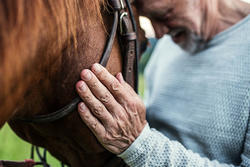Freed of pain
Where drugs failed, U of M researchers helped suffering horses regain pain-free movement. This new approach has profound implications for treating human diseases like osteoarthritis.

A family’s difficult choice
The mare arrived at the U of M’s veterinary clinic not long after giving birth and developing laminitis. She was in really bad shape and was suffering from the pain.
Laminitis is a painful disease of the nail bed of the hoof, that affects horses and other hoofed animals.
Everything had been tried. It was to the point where the family was considering euthanasia. Always a difficult choice, here it would also mean taking the mother from her foal.
“At the very least we wanted to help control the pain and buy the mother some time,” says Alonso Guedes, professor of anesthesia and pain medicine in the University of Minnesota’s Department of Veterinary Clinical Sciences.
Guedes asked the family’s permission to try an experimental compound he’d used successfully on several horses but had never tried on a nursing mare. The family approved.
The result was amazing. The mare responded immediately—she was able to continue to produce milk and care for her baby.
Unfortunately it's very expensive to maintain a horse in an experimental setting, and soon the mare needed to return home. After a few weeks without the experimental treatment, her condition worsened and she was euthanized. (Had the new treatment been at the point in development where it could be sent home with her, she might be alive today.) The mare’s extra weeks of life helped her foal survive.
Laminitis: a disease in the hoof and an enzyme’s hidden role
Laminitis is a disease that affects horses and other hoofed animals. It starts with damage to the nail bed of the hoof, and then a breakdown happens because the body lacks the ability to restore itself.
Laminitis is very painful and often leads to the death of the animal, usually by humane euthanasia.

Professor Alonso Guedes and a patient

Laminitis is a painful disease of the nail bed of the hoof
Guedes and other scientists have been studying laminitis for years. “What we found,” he says, “is that when the presence of a particular enzyme (sEH) is significantly elevated in the damaged tissue, then the body’s natural ability to repair itself can’t take place.”
The researchers also discovered something else—when they applied a compound that lowered the level of the enzyme in the damaged tissue, the animal was able to recover.
Guedes’ first attempt at treating a horse with laminitis was an instant success. “We used the compound, and within a few hours the horse was doing better,” he says. “The horse is still alive today.”
After publishing that first positive case, Guedes and his research team continued to enroll similar cases—horses for whom no other treatment had worked and who were faced with being euthanized.
Most of the horses responded very well. A few didn’t respond.
“It’s really important that we continue to do the research,” Guedes says. “The enzyme is encoded by a particular gene that probably doesn’t get expressed in every individual in the same way.”
Profound implications: treating human diseases like osteoarthritis
Discoveries for treating laminitis in horses may hold profound implications for treating degenerative joint diseases in humans.
“As in laminitis so in osteoarthritis—there is inflammation,” Guedes says.
In general, inflammation is a good thing. It helps tissues repair and protect themselves. But when inflammation becomes chronic it ends up destroying the tissue cells. If we look at the at the cartilage in an arthritic joint, cell loss is a big problem. Bone moves on bone, causing pain and impairing mobility.
Becoming less mobile has a huge effect on quality of life. People with osteoarthritis are more susceptible to depression, and to death from diabetes and heart disease.
Crucial questions remain. Can lowering the presence of the enzyme sEH enable the body to repair its damaged cells? Can we slow joint deterioration? Most importantly, can we prevent deterioration by intervening early on?
“We want to understand how this enzyme works,” Guedes says. “We are seeking to decrease the pain, slow the disease, and ultimately heal the body.”
- Categories:
- Health
Meet the people behind the story

Alonso Guedes
Associate professor of veterinary anesthesia and pain medicine, College of Veterinary Medicine



